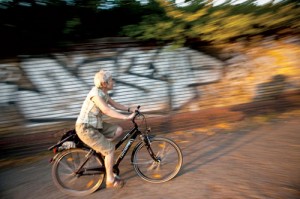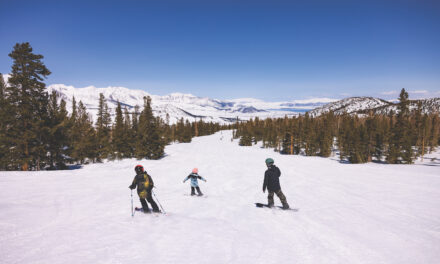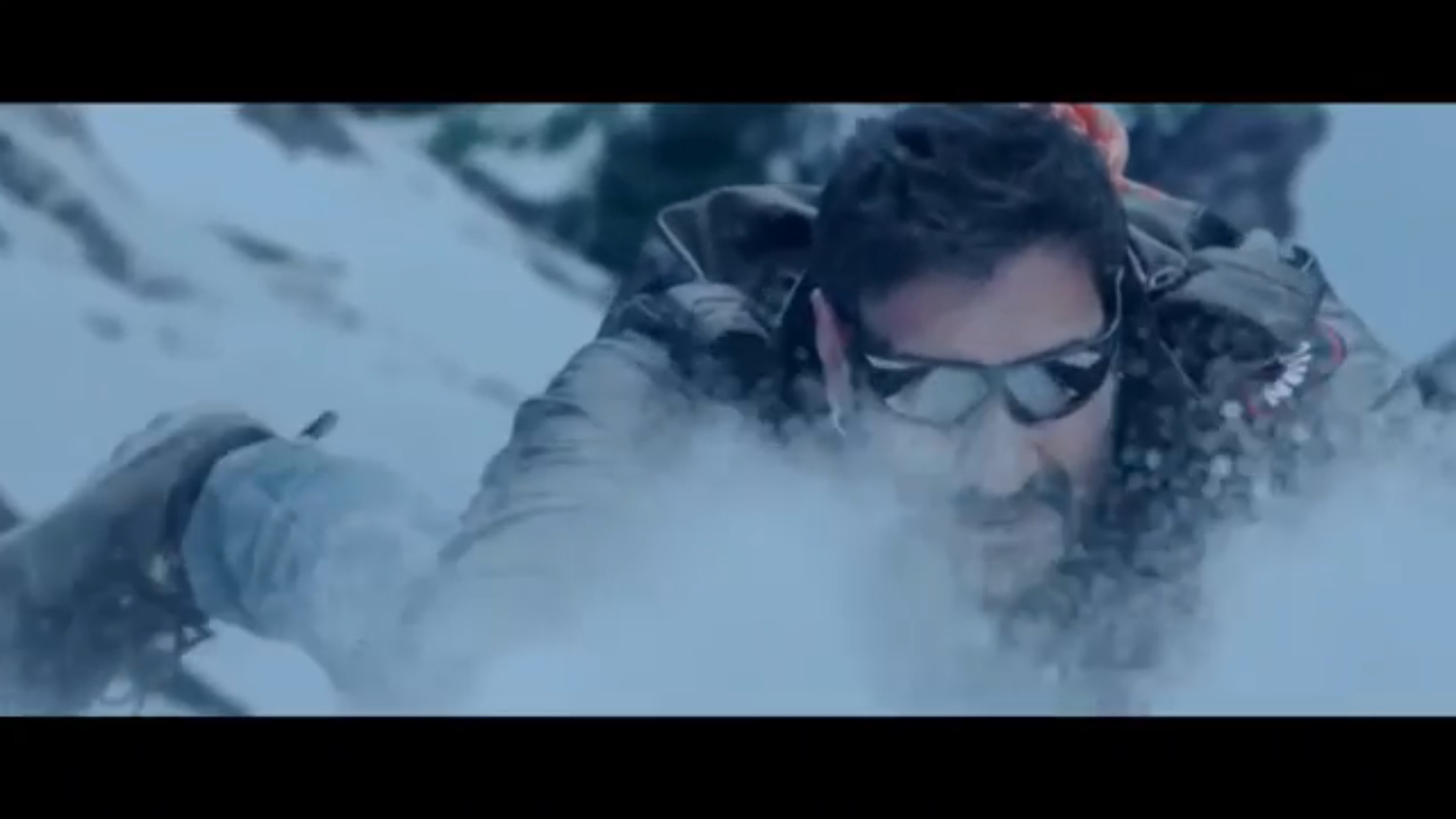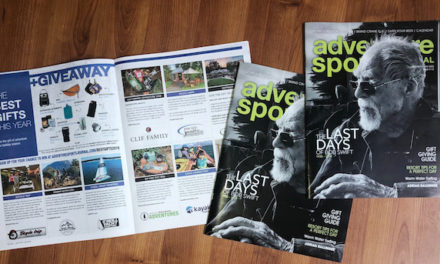- Tahoe’s Nevada Beach Tops the List of Hard-to-Book Campgrounds - 07/17/2024
- Cannabis Watershed Protection Program Cleans Up Illegal Grow Sites - 07/10/2024
- French Fire - 07/05/2024

'Mauer Mama' (cora Schaumann) rides into the center of Berlin's Wedding district

'Mauer Mama' (cora Schaumann) rides into the center of Berlin's Wedding district
With the 20th anniversary of the fall of the Berlin Wall, our writer hops the pond to pedal the Cold War’s most iconic bicycle path
By Bruce Willey
Aside from the hum of spokes and the rattle of a loose fender, the forested hinterlands are deadly quiet. The cycling trail I follow, dubbed the Berliner Mauerweg (“wall way”), often utilizes the patrol roads that once ran alongside the Wall. A mere two decades in time separate my journey from German Shepard hunds nipping at my pedals and a hailstorm of machine gun fire.
This former bonescape of searchlights, guard towers, barbed wire, and trigger-happy soldiers possessing shoot-to-kill orders, has faded into a mostly harmless bicycle path. Twenty-year-old pines and birches seem intent on both smacking me in the head and smothering the incriminating memory of this once notorious death strip. Under my tires, tree roots and blades of grass climb through the cracked asphalt, the natural world asserting itself over all this historical baggage. It makes for a rough ride.
But pedaling toward the southern outskirts of Berlin’s Teltow district, I begin to wonder if I am indeed on the Mauerweg at all. Wonder if indeed I’m still following the bitter, emblematic icon of the Cold War. In the first 15 or so miles, I’ve seen nary a concrete vestige or archeological trace of the actual Wall. The arbitrary and jagged way the border scissors across the landscape, yes. On the right side of my handlebars, the houses and apartment buildings seem like they were arrested for sprawl at the border, while on the left side, proletariat pastures and fields of wheat bask in the golden, late afternoon sunshine.
Stopping, I pull out my Radfahrplan (bicycle map) of Berlin. A woman on a bicycle, laden with two cotton bags of groceries, comes down the path. She says something to me in German, which goes into one ear, swirls about my brainpan without registering and prompts a mixed bag of phrases that are not quite connected to my tongue.
“Mein Deutsch is schlecht (my German is terrible),” I say, my practiced defense against meine linguistic inadequacies.
“My English is bad also,” she says.
“I’m somewhat lost,” I tell her. “I am riding the Mauerweg.”
“Yeah, yeah, yeah, the Mauer,” her face lighting up with recognition. She sweeps her hand up and down the street. “Die Mauer was here.”
“That’s good,” I say.
“Yah, good for you, not good for us,” she laughs.
Hair dyed pitch black, the same shade as her pants, Claudia lives three blocks away, but tells me she grew up in East Berlin. Straddling our bikes in the middle of the path I feel the same compulsion West Germans felt when the Wall came down—it was fashionable to claim you had a friend who was an Ossie, an East German. But my first interaction with a real-life, former Ossie is somewhat disappointing after I prod about her history.
The Stasi (East German secret police) kept a tight reign on their citizens, infiltrating nearly every aspect of their lives. People were often short-roped into becoming informers. Arranged in some horizontal filing cabinet from Hell, the files on Berlin citizens alone would stretch half way around the Mauerweg—50 miles, give or take a few files.
No doubt this black blossom of friendship is not helped by the fact that I pull a tape recorder out, a communist-era fau paux. It might be 20 years after the fact, but an Ossie, might still get skittish around such Stasi tackle. Sudden and deliberate change of subject: She asks where I am from.
California, I tell her. Claudia lightens considerably. She wants to know if it is possible to see movie stars. Living in California most of my life I’ve always assumed movie stars to be like the sunshine: you don’t think about it much unless you’re in the darkness of a movie theatre. I’m about to blither on about the differences between Northern and Southern California, how she might prefer San Francisco and a week-long trip to Death Valley rather than running her hands over the gum-stained sidewalk stars on Hollywood Boulevard. Germans love nature and big open space, right?
I put away my tape recorder and make another attempt about what it was like to live with the Wall. Claudia pauses, “It was … what is the word? Poison. We had poison then.” She pushes at the handlebars of her bicycle. “Tchüß,” she says, the sing-songy good-bye that remains in my ears, “Cheers” with a lisp.
At a bridge over the Teltow Canal, I miss another Mauerweg sign. Those who would rather forget the Wall vandalize the signs. Or maybe they must find pleasure knowing this Amerikanisch cyclist will become hopelessly lost. Diverging away from the river, past an open field of gravel and grass, is a vacant lot filled with concrete slabs. Wait a minute… is that what I think it is? I make a u-turn.
Sure enough, socked against the trees are the remains of the Wall. Some sections are tipped sideways; others stand straight, arranged together like a chock-a-block version of Stonehenge. I walk the bike through the weeds, overcome by my discovery. Here they are, a forsaken Mauer riot in various states of decay without the baggage of a tourist trap. All are the same size: about three-feet wide, 12-feet high, and graced with a three-foot concrete “shoe” attached at the bottom. Most sport graffiti. Then again, what spare piece of concrete real estate in Berlin doesn’t?
This is a city where one can find coffee table books devoted to Berlin’s virtuoso spray paint artists. Before the Wall came down, everyone from the Berlin Symphony to the shirtless techno dude reaped generous government money, a budget that far surpassed the United States’ entire cultural budget. But reunification cost a lot and nowadays artists can once more claim starving-status. Berlin’s mayor, Klaus Wowereit, once famously declared, “Berlin is poor, but sexy.”
These Mauer sections are what West Berliners saw before they were sexy and united. Easterners only saw the “hinterland wall,” the first thing they associated with any barrier. Except this was not even close to being a free association. Rather, they were forced into a state of denial worthy of Orwell. By the 1980s, Easterners were forbidden to call it a Wall. It was as if by remaining nameless it would cease to exist.
What had begun as a quaint barbed wire fence, hastily erected during the night of August 12, 1962, morphed into a high-tech barrier by the 1970s, one that was equally impossible to thwart or deny. Walking amongst these sections of concrete, I am a bit overwhelmed by the history of these slabs. Not one to deny an emotional experience when I see one, it reminds of the walls still up in the world, keeping some in, keeping some out, but never the innocent walls and fences that make for good neighbors.
****
So, save from actually going back in time and getting shot at, I figured pedaling around the entire Mauerweg might be the best way to comprehend the Wall. That is, without wading through a museum or succumbing to the gaily-painted pieces of the Wall in central Berlin that so often trap tourists. So I bought a used bicycle, one like every bicycle you see in Berlin complete with fenders, lights, and a rack for groceries.
Given that my cycling skills are meager leftovers from my pre-driver license days, I wasn’t exactly sure what a hundred miles meant on a bicycle. I’m wan to mention Lance Armstrong and myself in the same sentence, yet it did give me a few ounces of inspiration to know he does 100 miles before his first protein shake.
Which is what I thought I would do: Ride around the Wall in one go. Then it dawned on me: Why hurry? By going fast I have no time to soak in the history or the biergarten.
A few months before the Wall’s demise, Henning Wegenbreth, leader of a dissident cycling club, printed a poster (illegal) with a man holding a bicycle with the words, “Cyclists have nothing to lose but their chains.”
No offense to Lance, but this would be enough inspiration to get my old bike and me around the Wall. By breaking the Mauerweg into manageable sections (25-40 miles or so) and ending each ride at an S-bahn station, I could be “home” for dinner at my sister-in-law’s flat in Steglitz, a southern Berlin borough.
Make that dead sister, sadly. Friederika died of brain cancer, five-years ago, the same year she received her Ph.D. in botany at the age of 30. My wife and I stay there amongst her well-watered plants and scientific books, stuff her parents don’t have the heart to amend. We try our best to breathe life into the place while we’re there, leaving a stray hair in the tub or a wool coat in the closet. Once we’re gone, though, the flat remains a museum to her memory.
I pick up the trail from the day before. A long, perfectly straight trail takes off through forests and emerges from the pines, past stately villas once owned by prominent Jewish film stars, forced to flee (or worse) from the Nazis. Nearby is Babelsberg Film Studios. Here, Fritz Lang made the classic Metropolis and Nazi propagandist Joseph Goebbels’ spread his crafted hate. Soon I’m at the foot of the Glienicker Bridge, scene of so many American spy movies.
The trail winds along the Havel River, sailboats bending in the wind. At Wannsee, I catch a ferry to Kladow and find a biergarten to study the map. Fortified with a tall Hefeweizen and a sense of direction, I pedal past leafy neighborhoods on the water and into the fields and forests of Spandau. In an odd twist of Soviet-style environmentalism, the restricted area around the Wall preserved the land. Mile after mile of nature preserve.
At a farm near Eiskeller (ice cellar), the fields of wheat begin to make me thirsty for another Hefeweizen. But looking at the map I’m in the middle of nowhere. Stupidly, I have brought no water, no food. All we have to lose are our chains.
Not a moment too soon, I pedal into a biergarten under thousand year-old oaks. Ordering the tallest available Hefeweizen, I pull out the map, astonished at how far I’ve come.
By the time I find an S-bahn station, the sun has set. In the train, I prop my weary legs on the seat, watching the city whiz by with mechanical velocity. Three drunken teenage couples pile around, making out in the yellowish glow of the car’s light with rowdy affection. A beer bottle skitters across the floor and hits my bike tire.
“Entschuldigung Fahrad” (excuse me, bicycle), one of the boys says. They all laugh and one gives me a smile. Young Berliners displaying their adolescent version of the famous Berliner Mentalität (Berlin mentality)—witty, worldly, cynical.
****
After a rest day, my mother-in-law joins me. Cora Schaumann, whom I’ll rename Mauer Mama after we ride the next section of trail—both for her cycling skills and indefatigable energy—has lived in Berlin all her life. She was also a judge who presided over many cases of contested property rights during reunification.
As we pick up from where I left off in Henningsdorf, she attempts to illuminate a typical case for me. The smooth path we started on gives way to bone-rattling cobblestone, giving her story a peculiar vibrato. The GDR seized buildings from private owners. After the Wall fell, the former owners came back to claim what was, and sometimes wasn’t, rightfully theirs. Often claims went back to pre-WWII, back to the Nazis’ who took whole apartment buildings from the Jews, sending them to concentration camps. Problems arose when tenants claimed they had made improvements on the properties and wanted to be compensated.
“It was very, very complicated,” Mauer Mama says.
Soon we’re on a smooth path, riding past an old guard tower swallowed in vines. Slowly we dip back into civilization, passing a massive East German housing complex; some of these complexes were designed to hold 150,000 souls. Far in the distance, peeking over the trees is the Fernsehturm (TV tower) in downtown Berlin, sticking 1200 feet into the sky like a hypodermic needle. Airliners, on approach to Tegel Airport, fly overhead. “Sound of mobility,” Mauer Mama says, “taunted East Berliners.”
Passing a sign that reads Baum Schule, I ask: “You mean to tell me even trees go to school in Berlin?” No, Cora explains, it’s simply a garden nursery.
In a bushy stretch of dirt trail next to the unbearable stench of a hunde schule (dog pound), we pick up the pace. The unseen, but sniffed inhabitants bark savagely at us. Mauer Mama says she wouldn’t want to ride alone here.
Near the outskirts of Wedding, we come upon a 40-foot section of still standing Wall, pecked with holes. “Mauerspechte,” Cora says. During the weeks following the fall of the Wall, the Mauerspechte (“Wall pickers”) hammered away at the concrete, selling pieces to tourists. Even the GDR got in on the action, selling off large sections to museums, wealthy collectors, and corporations. The Mauer writ large around the world.
Darkness overtakes us as we ride through Wedding, a mostly working class district north of Mitte (middle). We switch on our lights, riding past Bernauer Street, scene of people jumping out windows to freedom, sometimes to their death. One man improvised a hot-air balloon, only to get electrocuted in the power lines. Mauer Mama enters the long hallway into the Nordbahnhof station, still riding despite this being unlawful behavior. I follow her: What exactly will the police do with a 69-year-old retired judge and a clueless American?
****
Unlike World War II for which I have no personal recollection, I can still conjure jumbled remnants of the Cold War from my memory. The usual stuff—JFK’s ich bin ein Berliner, tanks posturing at Checkpoint Charlie, Reagan’s cowboy call, “Mr. Gorbachev, tear down this wall”— banged into my brain by a high school history teacher who winced every time he said communist. He probably didn’t know it then, but he shared the opinion of East Berlin’s supreme leader, Chairman Erich Honecker, who, just three months before the Wall fell, predicted it would last “one hundred years.”
Both East and West played their propaganda cards well. Probably my western bias burbling to the surface, but the GDR was especially adept at it. After all, it was the East German government officials who called it the “Antifascist Protection Rampart.” To me this sounds like plain-old bureaucratic bullshit at best, outright falsehood at worst. But I suppose we all fictionalize our own past to suit the needs of the present.
But for Berliners it is infinitely preferable to live in the present rather than grapple with the horrors of the last 100 years. It may be why they’re so good at having a good time. The historical paradoxes are everywhere, but one fine place to enjoy them is at a Strandbar.
Riding east from the Brandenburg Gate and past the tourist-riddled Checkpoint Charlie, I make a short detour down Karl Marx Allee, taking in some grand Soviet-style urban planning. Then, veering south, I bump into a mile-long section of the Wall, the Eastside Gallery. Tucked behind it is YAAM, a piece of Jamaica dropped smack down in the middle of the former death strip. Palms beckon above the sand under which Berliners sit in beach chairs next to the Spree River. I grab a mango-laced Hefeweizen (not recommended) and carve out my spot with a book. A dreadlocked man in soccer shorts cruises the sand selling das ganja.
The sun disperses behind the buildings across the water, bringing an instant chill to the air. Time to make tracks for home. But searching for the S-bahn station, I get mired in the kinetic streets of Kreuzberg. I stop for directions and find Yomo Wagner. His English is better than mine, which is to say he has a Cockney accent. Wagner grew up in West Berlin and says before reunification it was a lot harder to get lost. “You always knew that eventually you’d run into the Wall.”
****
By the time I complete the 37-mile Kreuzberg to Lichtenrade run, I’m starting to get the hang of navigating the Mauerweg. My legs feel strong, my dreams filled with street signs. There’s just one small 12-mile section to complete. Mauer Mama is game, so we go finish the last leg together. That, and I want to show her the place I dubbed Mauerhenge, where I basically began my journey.
It’s been nearly a week of riding, and the Mauerweg has already begun to consume my thoughts in a blur of spokes. After a pleasant pedal along a canal we reach the Mauerhenge. Mauer Mama is amazed there’s so much of the Wall left. In the evening light she plays with her shadow, raising one arm high over her head, her arthritic fingers crooked to make what looks like an ostrich splayed on the Wall. I do the same.
“High-five,” I say, slapping the shadow of her hand.
Mauer Mama looks confused.
“It’s what American males do when they’ve completed something,” I say. “Sort of like clapping, but with two people.”
“Yeah, yeah, I know,” she says.
She stretches her arm higher, meeting my shadowed hand with hers until they cross, banging silently in the air.
Bruce Willey is a freelance writer and photographer who splits his time between California’s Eastern Sierra and Atlanta, GA, when not stumbling about Berlin. He’s typically more comfortable sticking to rock than a bike seat, but for a good story and a Hefeweizen he’ll mount up, sans spandex. You can see more of his musings and images at www.brucewilley.com.













